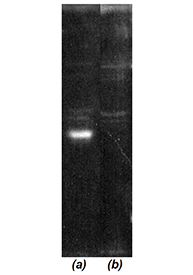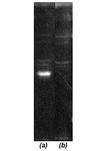| Host: | Rabbit |
| |
| Immunogen: | Synthetic peptide corresponding to aa 283-297 of human COP9 signalosome (Csn6 subunit). |
| |
| UniProt ID: | Q7L5N1 |
| |
| Source: | Purified from rabbit serum. |
| |
| Species reactivity: | Human
|
| |
| Specificity: | Recognizes the Csn6 subunit of the COP9 signalosome. |
| |
| Crossreactivity: | Does not cross-react with other signalosome subunits. |
| |
| Applications: | WB
|
| |
| Recommended Dilutions/Conditions: | Western blot (an initial dilution of >1:1000 is recommended)
Suggested dilutions/conditions may not be available for all applications.
Optimal conditions must be determined individually for each application. |
| |
| Application Notes: | Western Blot: The antibody has been characterised against both endogenous and purified signalosome preparations. Detects a band of ~33.5kDa. |
| |
| Purity Detail: | Partially purified immunoglobulin. |
| |
| Formulation: | Liquid. In PBS containing 10mM sodium azide. |
| |
| Shipping: | Blue Ice |
| |
| Long Term Storage: | -20°C |
| |
| Scientific Background: | The polyclonal antibody to Csn6 was generated by immunisation of rabbits with a synthetic peptide corresponding to residues [283-297] of the human Csn6 sequence. The antibody has been characterised by one-dimensional Western blotting. Vial contains a partially purified immunoglobulin preparation suspended phosphate-buffered saline containing 0.01M sodium azide. The COP9 signalosome, once defined as a repressor complex of light activated development in Arabidopsis, has recently been found in humans and is probably present in most multicellular organisms. The COP9 signalosome is closely related to the lid sub-complex of the 26S proteasome in structural composition and probably shares a common evolutionary ancestor. A multifaceted role of the COP9 signalosome in cell-signalling processes is hinted at by its associated novel kinase activity, as well as the involvement of its subunits in regulating multiple cell-signalling pathways and cell-cycle progression. The molecular genetic studies in Arabidopsis suggest that the complex functions as part of a highly conserved regulatory network, whose physiological rüle in animals has yet to be determined. The COP9 signalosome, also known as the the COP9 complex and JAB1-containing signalosome, is a conserved nuclear protein complex found in plants and animals. It is composed of eight distinct subunits, designated S1 to S8 (very recently re-designated Csn1-Csn8) according to the molecular weight of the mammalian complex subunits. Subunit composition and the subunit sequences are substantially conserved between the mammalian and the plant complexes, implying that the complex has a conserved cellular function in higher eukaryotic organisms. The role and function of Csn6 has yet to be determined although this subunit is known to interact with subunits Csn2 and Csn7 within the COP9 signalosome. |
| |
| Technical Info/Product Notes: | Immunoblotting - The antibody has been characterised against both endogenous and purified signalosome preparations. The antibody does not cross-react with other signalosome subunits. An initial dilution of >1:1000 is recommended.
Immunoprecipitation – No information currently available.
Immunohistochemistry - No information currently available. |
| |
| Regulatory Status: | RUO - Research Use Only |
| |












